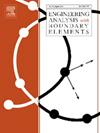利用导数分解和多重互易技术减轻不可压缩扩散-平流传热问题中极点的要求
IF 4.1
2区 工程技术
Q1 ENGINEERING, MULTIDISCIPLINARY
Engineering Analysis with Boundary Elements
Pub Date : 2025-10-09
DOI:10.1016/j.enganabound.2025.106498
引用次数: 0
摘要
将导数分解技术应用于直接插值边界元法求解不可压缩扩散-平流传热方程。尽管获得了更好的精度,但主要目标是开发一个使用分解技术的准确模型,旨在减少对内部极点的需求,以解决与平流效应相关的域积分。因此,该模型是结合著名的多重互易法推导出来的,该方法首次应用于扩散-平流方程。在本研究的贡献中,必须强调导数技术的重要作用,因为速度场通常以笛卡尔坐标表示,这通常需要径向近似,从而损害其精度。然而,这些分量可以用标准分量和切向分量来表示。考虑到沿边界的径向函数的导数比法向导数更精确,并且这些法向导数可以直接包含在矩阵方程中求解,多重互易方法的使用变得可行和有利,在扩散-平流模型中也是如此。这种组合的方法产生了一个模型,减轻了扩散-平流问题对内部极点的要求,特别是在低psamclet数时。本文章由计算机程序翻译,如有差异,请以英文原文为准。
Mitigating the requirement of poles in incompressible diffusive-advective heat transfer problems using the decomposition of derivatives and the multiple reciprocity techniques
The Derivatives Decomposition Technique is presented, applied in the context of the Direct Interpolation Boundary Element Method, to solve the incompressible diffusive-advective heat transfer equation. Despite achieving better accuracy, the primary objective is to develop an accurate model that uses the decomposition technique, aiming to mitigate the need for internal poles to solve the domain integral related to advective effects. Thus, the model is derived in conjunction with the well-known Multiple Reciprocity Method, which is first applied to the diffusive-advective equation. Within the contributions of this research, the significant role of the derivatives technique must be highlighted, as the velocity field is usually expressed in terms of Cartesian coordinates, which commonly requires radial approximations that compromise its precision. However, such components can be expressed in terms of standard and tangential components. Given that the derivatives of radial functions along the boundary are more precise than the normal derivatives, and that these normal derivatives can be included and solved directly in the matrix equation, the use of the Multiple Reciprocity Method becomes viable and advantageous, also in diffusive-advective models. This combined methodology yields a model that mitigates the requirement for internal poles for diffusive-advective problems, particularly at low Péclet numbers.
求助全文
通过发布文献求助,成功后即可免费获取论文全文。
去求助
来源期刊

Engineering Analysis with Boundary Elements
工程技术-工程:综合
CiteScore
5.50
自引率
18.20%
发文量
368
审稿时长
56 days
期刊介绍:
This journal is specifically dedicated to the dissemination of the latest developments of new engineering analysis techniques using boundary elements and other mesh reduction methods.
Boundary element (BEM) and mesh reduction methods (MRM) are very active areas of research with the techniques being applied to solve increasingly complex problems. The journal stresses the importance of these applications as well as their computational aspects, reliability and robustness.
The main criteria for publication will be the originality of the work being reported, its potential usefulness and applications of the methods to new fields.
In addition to regular issues, the journal publishes a series of special issues dealing with specific areas of current research.
The journal has, for many years, provided a channel of communication between academics and industrial researchers working in mesh reduction methods
Fields Covered:
• Boundary Element Methods (BEM)
• Mesh Reduction Methods (MRM)
• Meshless Methods
• Integral Equations
• Applications of BEM/MRM in Engineering
• Numerical Methods related to BEM/MRM
• Computational Techniques
• Combination of Different Methods
• Advanced Formulations.
 求助内容:
求助内容: 应助结果提醒方式:
应助结果提醒方式:


